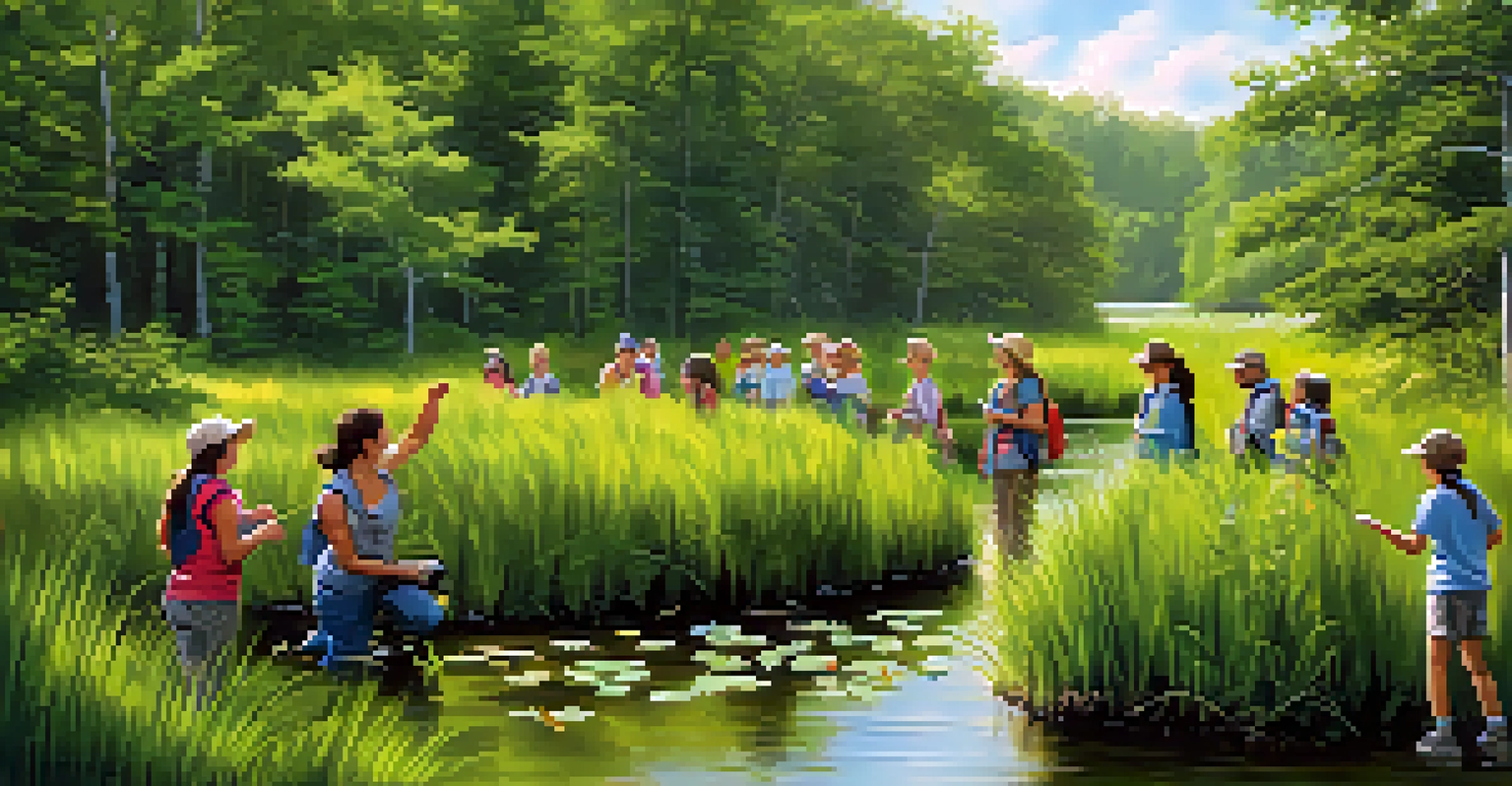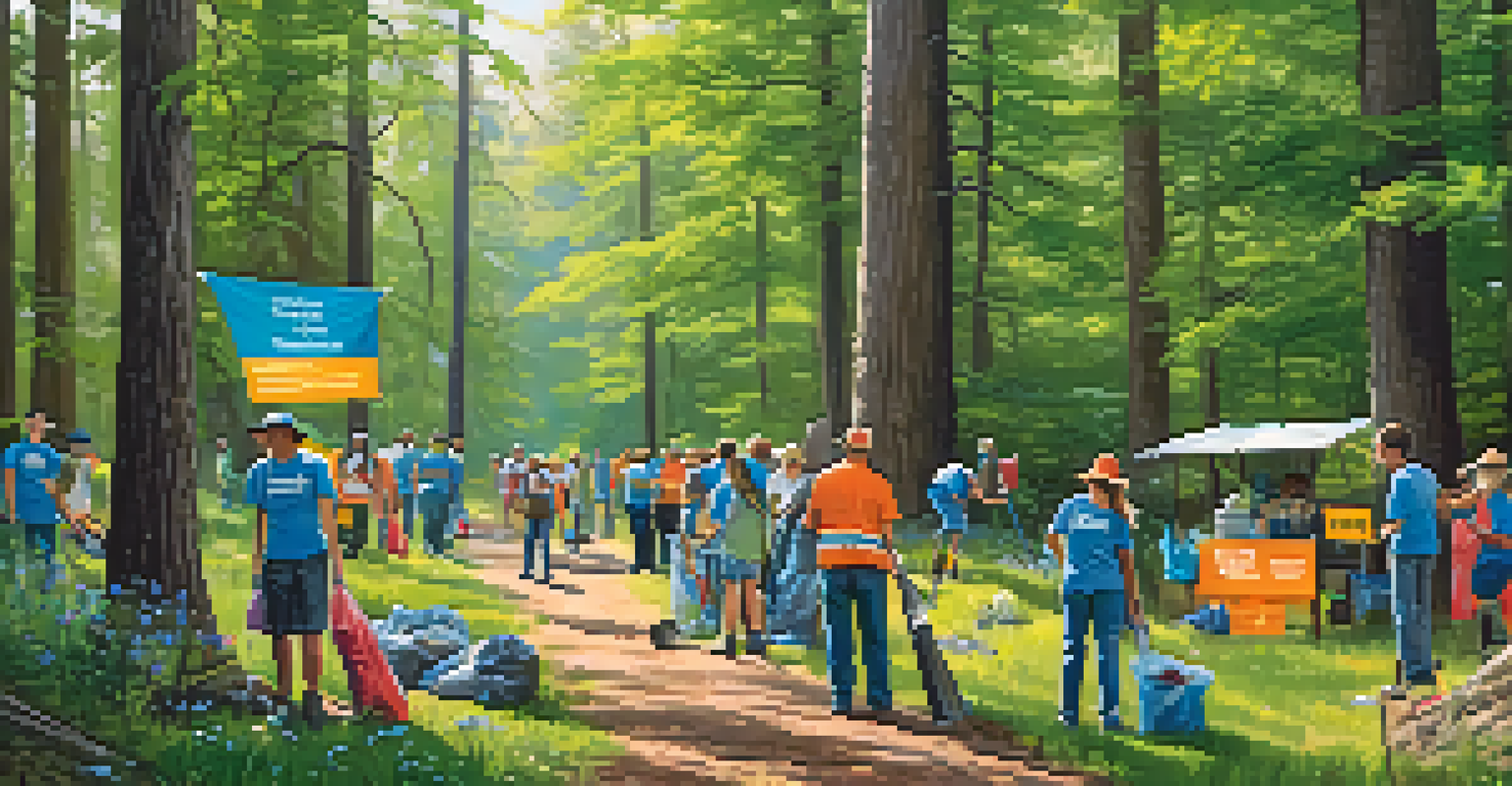The Importance of Conservation in Illinois State Parks

The Rich Biodiversity of Illinois State Parks
Illinois State Parks are home to a stunning array of plant and animal species. From the lush forests of Starved Rock to the wetlands of Cache River, these parks showcase diverse ecosystems. This biodiversity plays a vital role in maintaining ecological balance, providing habitat, and supporting wildlife. Understanding and protecting this variety is essential for sustaining the natural beauty and health of these areas.
The environment is where we all meet; where we all have a mutual interest; it is the one thing all of us share.
For instance, species like the Illinois chorus frog and the eastern prairie fringed orchid are unique to this region. When we conserve these habitats, we not only protect these species but also ensure that future generations can enjoy their beauty. Biodiversity also contributes to the resilience of ecosystems, helping them adapt to changes like climate fluctuations.
Ultimately, the richness of biodiversity in Illinois State Parks highlights the importance of conservation efforts. By prioritizing these initiatives, we safeguard the intricate web of life that thrives in our parks, ensuring a vibrant natural legacy.
Preserving Natural Resources for Future Generations
Conservation in Illinois State Parks is crucial for protecting natural resources. These parks are vital sources of clean air, water, and soil, which are essential for all living organisms. Preserving these resources not only benefits the environment but also enhances recreational opportunities for visitors. Ensuring that future generations can experience the beauty of nature is a responsibility we all share.

For example, sustainable practices, such as responsible fishing and hiking, help maintain water quality and soil health. When visitors engage in these activities thoughtfully, they contribute to the preservation of these essential resources. This balance allows us to enjoy outdoor activities while safeguarding the natural environment.
Biodiversity is Essential
Illinois State Parks harbor unique species, and their conservation is vital for ecological balance and future enjoyment.
In essence, conserving natural resources in Illinois State Parks is about creating a legacy. By fostering a culture of sustainability, we can ensure that these precious resources remain available for activities like camping, hiking, and wildlife observation for years to come.
Cultural Heritage and Historical Significance
Illinois State Parks are not just natural treasures; they also hold significant cultural and historical value. Many parks preserve sites that tell the stories of Native American tribes, early settlers, and pivotal moments in Illinois history. Recognizing and conserving these sites helps us understand our past and shapes our identity as a community.
In every walk with nature one receives far more than he seeks.
For instance, parks like Cahokia Mounds offer insight into the ancient civilizations that once thrived in the region. By protecting these historical sites, we honor the legacy of those who came before us and provide educational opportunities for visitors. This connection between nature and history enriches our experience in the parks.
Thus, the conservation of cultural heritage in Illinois State Parks enhances their value. It creates a deeper appreciation for our surroundings while fostering a sense of pride and responsibility toward preserving our shared history.
The Role of Education in Conservation Efforts
Education plays a pivotal role in conservation efforts within Illinois State Parks. Through various programs and workshops, visitors can learn about local ecosystems, wildlife, and sustainable practices. This knowledge empowers individuals to become active participants in conservation efforts, fostering a sense of stewardship for the environment.
For example, guided nature walks and school field trips provide hands-on experiences that inspire a love for nature. By engaging with experts, visitors gain insights into the importance of conservation and how their actions can make a difference. This education not only benefits the parks but also cultivates future environmental advocates.
Community Drives Conservation
Local volunteers and organizations play a key role in conservation efforts, fostering a sense of pride and ownership in the parks.
In summary, education is a key component in promoting conservation in Illinois State Parks. By equipping people with knowledge and skills, we can create a community that values and actively participates in protecting our natural resources.
The Economic Benefits of Conservation
Conservation in Illinois State Parks also brings significant economic benefits to local communities. Parks attract millions of visitors each year, contributing to tourism and boosting local businesses. When people come to enjoy the natural beauty, they spend money on accommodations, dining, and recreational activities, creating jobs and stimulating the economy.
Moreover, investing in conservation leads to enhanced property values and quality of life for residents. Clean parks and preserved landscapes make communities more attractive to potential homebuyers and businesses. This creates a win-win situation where both nature and the local economy thrive.
Ultimately, the economic advantages of conservation underscore its importance. By prioritizing conservation efforts, we not only protect the environment but also foster economic growth and stability in our communities.
Challenges Facing Conservation in State Parks
Despite the importance of conservation, Illinois State Parks face numerous challenges. Issues such as climate change, invasive species, and budget constraints threaten the health of these natural areas. Addressing these challenges requires a collaborative effort among government agencies, conservation organizations, and the community.
For example, climate change can disrupt local ecosystems, leading to shifts in species distribution and habitat loss. Invasive species can outcompete native flora and fauna, further stressing already vulnerable environments. Recognizing these challenges is the first step toward implementing effective solutions and ensuring the continued vitality of our parks.
Conservation Boosts Local Economies
Investing in conservation not only protects natural resources but also enhances tourism and economic stability in surrounding communities.
Therefore, understanding the challenges of conservation is essential for effective action. By working together and fostering awareness, we can overcome these obstacles and protect Illinois State Parks for future generations.
Community Involvement in Conservation Initiatives
Community involvement is crucial for the success of conservation initiatives in Illinois State Parks. Local volunteers and organizations play a vital role in restoration projects, clean-up events, and educational programs. When individuals come together to support these efforts, they foster a sense of ownership and pride in their natural surroundings.
For instance, community clean-up days not only beautify parks but also raise awareness of the importance of keeping our environment clean. Engaging with local schools and groups can inspire the next generation to appreciate and protect nature. This collective effort strengthens the bond between people and their parks.

In essence, community involvement amplifies the impact of conservation initiatives. By working together, we can create a sustainable future for Illinois State Parks, ensuring they remain cherished spaces for everyone.
Conclusion: A Call to Action for Conservation
In conclusion, the importance of conservation in Illinois State Parks cannot be overstated. From preserving biodiversity to enhancing local economies, the benefits are far-reaching. As stewards of these natural treasures, it is our responsibility to advocate for conservation efforts and engage with our communities.
By participating in educational programs, volunteering, or simply enjoying the parks mindfully, we can all contribute to the preservation of these vital resources. Each action, no matter how small, makes a difference in ensuring that Illinois State Parks thrive for future generations.
Let us come together and commit to protecting the beauty and integrity of our parks. Together, we can create a sustainable future where nature and community coexist harmoniously.